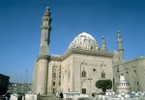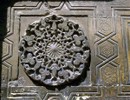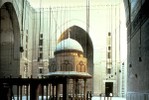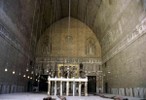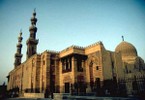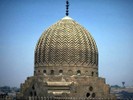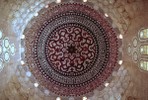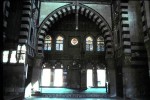Previous Lecture | Next Lecture
Concepts
Qubba: Arabic for dome, used in medieval terminology for mausolea. The domes of Cairo are among the most impressive examples of vault architecture, especially for the carved stone domes over tombs, and more particularly for those of the late Mamluk period which excelled in geometric and floral patterns carving on the convex dome surface.
Qa'a-Mosque Type: Probably a development borrowed from residential architecture, this type has a qa'a plan (the most common hall type in Egypt), which normally has two iwans facing each other on the main axis, with wall recesses on the two remaining sides, while the central space is covered with a wooden cupola.
Sabil-Kuttab: A charitable structure composed of a sabil (drinking fountain) on the ground floor, and a kuttab (Qur'anic school for boys) on top, which was usually a room open on all sides.
Monuments
The Mosque of Sultan Hasan
(1356-61). The most monumental of all Cairene mosques, it stands like a fortress across from the Citadel of Cairo. The structure is a four-iwan, four-madrasa composition with a mausoleum right on the qibla axis of the mosque. The huge portal is oriented to impress the viewer coming from the Citadel. Its minarets mark the beginning of the line of development of the 3-tiered Mamluk minarets.
The Khanqah of Sultan Faraj ibn Barquq
(1400-11). A very symmetrical composition which contains a hypostyle mosque, cells for sufis, and two minarets and two carved stone qubbas, which are the largest stone domes in Cairo.
The Funerary-Religious Complex of Sultan Qaytbay
(1472-74). Probably the most beautiful funerary complex in Cairo, it has a mosque, a madrasa, and a qubba. It also has the most elegant 3-tiered minaret and the most intricately-carved stone dome with stellar patterns.
The Mosque of Amir Qijmas al-Ishaqi
(1479-81). One of the most exemplary qa'a-type mosques, it sits prominently at a major intersection on al-Darb al-Ahmar, the main ceremonial thoroughfare in Cairo.
The Sabil-Kuttab of Sultan Qaytbay
(1479). The earliest stand-alone Sabil-Kuttab in Cairo, it establishes the type as a pietistic endowment in the urban milieu without it being attached to a larger religious complex.

